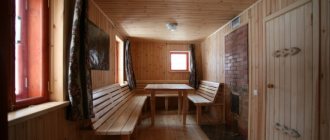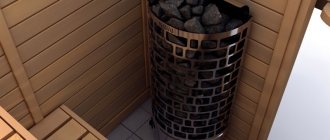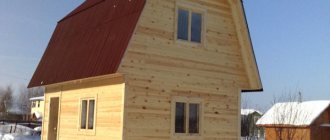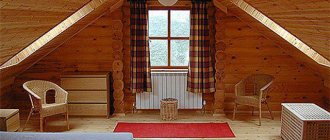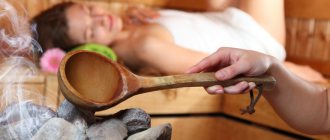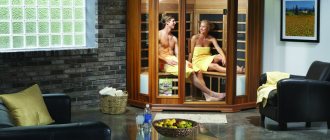“If there are brooms, an ice hole and tea, it’s a bathhouse, but when there’s vodka, barbecue and girls, it’s already a sauna.”
Greetings to all blog visitors!
There are many types of baths on earth. They are also found in Japan - Ofuro, Indonesia, Brazil and Mexico. Each relies on its own rituals and traditions. However, ours is both closer and dearer to us. But... still one of the “foreign” bathhouse cultures managed to put down strong roots on Russian soil.
This is a Finnish sauna. And sometimes disputes arise: what is better, more useful, more correct. To me, this is like an argument about women. Blondes or brunettes, how to choose? Therefore, today we’ll talk about the difference between a sauna and a bathhouse. Neutral comparison, without emotions, essentially...
The ancestor of both baths is a log hut.
By the way, the Finnish people are indigenous people from Western Siberia. More precisely, from the territories of the current Khanty-Mansiysk Okrug. They are not Scandinavians. From ours it became...
Classic differences
One of the biggest differences is the steam. A Russian bath involves wet steam, but in a Finnish it is dry. Why is this being done? Steam saturated with moisture allows the use of air at low temperatures. Since humidity reaches almost a maximum, almost no sweat evaporates from the human body. Consequently, the body warms up much more efficiently, and the level of dehydration is almost minimal.
Dry steam will not allow sudden overheating. Since sweating is the main way of cooling the human body, a decrease in its evaporation in high humidity almost completely eliminates the possibility of normal thermoregulation. In saunas this risk is significantly reduced.
Conclusion
If you decide to make a steam room on your property, you need to decide on its type, because depending on the type chosen, you will have to equip the room completely differently. It is worth noting that a steam room in a sauna is much simpler to implement; there are many small stoves on sale, which come with instructions for use that guarantee a good result (find out here what materials can be used to build baths and saunas).
But in a Russian sauna it is much more difficult to achieve good steam, so it is worth deciding which solution will be best for you. We hope the video in this article will answer all questions, if any remain.
Did you like the article? Subscribe to our Yandex.Zen channel
Finnish sauna
Here, due to the use of dry steam, the humidity level is significantly lower - up to 15 percent. As for the sauna effect, it is based on alternating exposure to hot dry steam and cold water. Temperatures can reach up to 110 degrees.
The air pressure in saunas is the same as outside. And the air is dry. It has a low level of thermal conductivity and heats up well over 100 degrees. But this heat is very easily tolerated. In addition to the fact that the difference between a sauna and a Russian bath lies in the principles of operation and the use of different steam, there is also a difference in the design. Let's look at these features.
Benefits of a bath for colds
A runny nose is a disease in which the nasal mucosa is inflamed. This is a classic reaction of the body to contact with ARVI bacteria. There is a lot of debate about whether it is permissible to visit the bathhouse in this state. Experts believe that you can visit the bathhouse:
- during the initial stage of the disease;
- after the end of the acute period.
In these cases, the result of the procedure will be successful. Having considered the positive aspects of visiting a bathhouse, you can decide whether to go there if you have a cold or not. What we get:
- Steam inhalation. Moist steam is good for the respiratory tract. When you have a runny nose, you should use decoctions based on pine needles, eucalyptus, and mint. Aromatic steam and essential oils will soften the cavity of the nasopharynx, lungs, and bronchi. The process of discharge and removal of mucus will improve, which provokes coughing and nasal congestion. The risk of developing pathology in the form of sinusitis, tonsillitis, and pneumonia will be significantly reduced.
- Active, natural elimination of toxins. Staying in a steam room speeds up the metabolism of nutrients in the body. High air temperature causes increased sweating and removal of toxins. Therapy is useful at the stage of recovery and recovery.
- Elimination of the effect of aching joints. This is achieved by proper massage using brooms. It will remove unpleasant sensations, and the pleasant aroma of birch, linden or oak steam will cleanse the nasopharynx cavity.
Note! It is slagging in the body that delays recovery.
This helps to reduce immunity and increases the likelihood of encountering the disease. A prolonged runny nose may occur. Preventive bath procedures will prevent such consequences.
Design features: Russian bath
Often the building is located separately. Traditionally, a bathhouse is built from wood, often coniferous. A Russian bathhouse necessarily includes two rooms. This is a steam room and a dressing room, which is both an entrance hall, a locker room, and a relaxation room. All rooms must have a window. It is necessary for better ventilation.
In the dressing room there is a stove-stove, which is heated with wood. The main element that generates heat is stones - hence the name of the stove, which is usually built in the wall between rooms. Its main part, as well as the stones, are in the steam room.
Furnaces can be open or closed. Open solutions are considered more practical, especially when the bathhouse is used for its intended purpose several times a day. This stove warms up the room faster. However, due to frequent watering of stones, it quickly cools down. The stones for these structures are laid above the firebox. The oven can heat up to 300 degrees.
The closed-type device is equipped with a special steam door for better heat transfer. When wood is burned and the door is closed, no smoke enters the steam room. The oven can heat the stones to very serious temperatures. Before visiting the steam room, the door is opened slightly and the room is warmed up. The closed oven must be heated in advance - approximately two to five hours before starting the procedure. Due to the properties of the stones, this design can maintain heat for two days.
The difference between a bathhouse and a sauna lies in the design features, or more precisely in the arrangement of the stones. In the first case, they are placed inside the oven, so they heat up more strongly and cool down very slowly. In a sauna, stones are placed on the surface of the stove.
What materials are used
In most cases, bathhouses in the country are built from wood. Exactly the same material is used to build saunas. At the same time, only hardwood timber is used for construction. The fact is that with strong heating, ethereal resin vapors begin to be released from wood, for example, spruce or pine. And this may not be very healthy.
Hardwood boards are also used to assemble benches and shelves inside baths or saunas, as well as for cladding walls and floors. The released resin can not only harm the respiratory system. You can still get seriously burned by it.
Sometimes baths and saunas these days can be built from brick or, for example, concrete blocks. In this case, the bathhouse box is most often insulated. The materials used for these purposes these days are mostly modern. Both mineral wool and expanded polystyrene can be used for this purpose.
Finnish saunas
The premises for them can be either separate or built-in. The inside of the room is decorated in the same way as in a Russian bathhouse. Coniferous wood is used as materials.
What distinguishes a sauna from a Russian bath is the configuration of the room. Unlike Russian traditions, the sauna has three rooms. There is a steam room, a dressing room, and a shower. As for the steam room, it is smaller in area than in a Russian bathhouse, has no windows, but there is a forced ventilation system. The dressing room is characterized by its large size.
Traditional (wood-burning) and modern electrical solutions are used as a stove. Wood stoves can be of two types. Some are made of special refractory bricks, while others are made entirely of metal. The main elements in them are the heater and the chimney. The metal structure can be with a built-in heater or with a chimney and hearth. Brick kilns are very similar to Russian ones in their design.
In the first case, the stones are laid on top of the furnace and special screens. In the second, they are located in a horizontal chimney, where they heat up. Nowadays, electric ovens are most often used. They have many advantages over traditional wood-burning devices. The electric unit warms up faster, can automatically maintain the required temperature, and does not require the installation of a forced ventilation system or removal of combustion products. An electric oven can be closed or open.
Historical and traditional differences
The first mention of a bathhouse in Rus' was found in the Tale of Bygone Years (10th century AD). But some historians suggest that it appeared earlier (in the 5th century). The first baths were heated “black”. The stove was missing a pipe. The smoke and soot went directly into the steam room, heating it up. It was possible to steam only after ventilation. The smoke went outside, but the heat remained. We steamed in a Russian bathhouse using a broom. This action horrified foreign guests. It was perceived by foreigners as something barbaric and incomprehensible. A little later, stoves with pipes began to be used. The smoke immediately came out. This method of heating a steam room was called “white”.
In Rus', everyone used the bathhouse - from peasants to representatives of the royal family. The nobility preferred to use the services of public baths. And simple families had their own baths in a private courtyard.
The Finnish sauna, like the Russian bath, has a rich history. This is due to climatic conditions. People came to this place not only to wash themselves and take a break from the cold, but also to improve their health. Unlike Europe, the Finnish sauna is not mired in debauchery and unsanitary conditions. Strict rules of etiquette nipped indecent behavior in the bud. The Finns said that in a sauna you need to behave exactly the same as in church. In many ways, this rule made it possible to preserve and develop the traditions of dry steam.
The first Finnish saunas were portable. They looked like tents with improvised stoves. Then permanent buildings appeared - low dugout huts. They were drowned both “black” and “white”. In its traditional form, the sauna appeared at the turn of the twentieth century, when technology and building materials made it possible to make the room more comfortable and aesthetically pleasing.
Design Features
It is worth mentioning the design differences between a sauna and a bathhouse. The traditional Russian bathhouse is a stationary building. Coniferous trees are used to construct the building. They have suitable performance properties:
- resistant to changes in temperature and humidity;
- create the right microclimate;
- serve for a long time.
Attention! Modern construction technologies allow the use of other materials (brick, timber, silicate blocks). The interior decoration of the steam room is made of wooden materials.
The main rooms of the bath: steam room, dressing room and wash room. If desired, a recreation room, a kitchen, and a gazebo can be added to the project.
A Finnish sauna can look like a permanent structure or be part of a residential or commercial premises. The inside of the sauna is finished with wood. The material must withstand high temperatures and be protected from rotting. For a Finnish steam room, resin release is unacceptable. Preference is given to alder, cedar, abashi (African palm tree).
Main sauna rooms:
- shower;
- dressing room;
- steam room
The dressing room has a larger area. It is furnished. Serves as a rest room and locker room.
Temperature and humidity
The humidity level in the sauna should not exceed a threshold of 3 – 8%. Average temperatures range from 90 to 130 degrees Celsius. Sometimes humidity levels are increased to 25% to create milder conditions for visitors. Sweating occurs due to high temperatures.
These points distinguish a sauna from a bathhouse. The humidity of a Russian bath is 40 – 70%. It is not recommended to exceed these marks, as the steam will become heavy and saturated with moisture droplets. It is extremely difficult to take a steam bath in such a bath. The room temperature can range from 55 to 70 degrees. The body heats up more efficiently due to high humidity in the air.
Differences in ventilation
The peculiarity of the sauna is that there is no need to worry about the presence of steam. Ventilation in the room must work effectively. Every 6 – 10 minutes the air in the room is completely renewed. Most often, Swedish ventilation techniques are used for Finnish steam rooms. The role of the engine in the system is performed by the furnace. This is convenient because it works throughout the entire session. To ensure a constant flow of air, an inlet and a box with a damper system are installed next to the stove. The distance from the box to the floor should be at least 30 centimeters.
In a Russian bath, the ventilation arrangement is different. Since the main thing in the heating process is steam, it must be preserved. To ensure air change in the bath, 2 holes are used: the first for air inflow, the second for air outlet. The location of the holes depends on the design of the bathhouse. The efficiency of ventilation is affected by:
- Size.
- The height of the holes.
By type, ventilation is divided into:
- Natural. Occurs due to vents.
- Mixed. Additional equipment is used.
- Mechanized. Only mechanical equipment is used.
Experts recommend using natural or mixed ventilation for a Russian bath. They provide the correct microclimate and retain steam.
Differences between stoves
For a traditional Russian bath, a stove with a closed heater is used. To increase the amount of steam, open the door and pour water onto the stones. Thus, the temperature in the steam room lasts longer and is more comfortable.
The stones in the Finnish sauna stove are located outside. They heat the air more efficiently. Water does not pour on them. The stove can be equipped with an aromatherapy device.
Ventilation system
An important difference is in ventilation systems. The sauna experience is most optimal when the internal and external pressures are the same. How is a bathhouse different from a sauna? The traditional Russian version operates on the principle of excess pressure.
If there is no pressure difference in the room, then you will not be able to get good steam. Water vapor is formed inside the furnace volume. It turns out to be a small explosion. Then the steam goes into the steam room through the door opening. Some of it is reflected from the walls and sides of the furnace, due to which the excess pressure increases even more. After this, the steam is released outside. Since it is the hottest, it goes up to the ceiling.
Construction technology: foundation construction
Like any other building, a bathhouse or sauna begins to be erected by pouring a reliable foundation. Under the most popular log baths, since the walls made of such material are quite heavy, a strip foundation is usually poured.
The technology for constructing such a structure includes the following steps:
- marking using the Egyptian triangle method;
- digging a trench;
- backfilling of crushed stone-sand cushion;
- installation of formwork;
- installation of reinforcement frame;
- pouring concrete mixture;
- dismantling of formwork.
Marking for the foundation is carried out using pegs and a non-elastic cord. The trench under the strip base is usually dug manually. After such a ditch is ready, its bottom is leveled. Next, a layer of coarse crushed stone is poured into the trench. Smaller crushed stone is laid on top of it. Lastly, sand is poured into the trench.
The formwork for the foundation is made from ordinary boards. The reinforcement for the foundation for the bathhouse is knitted from 8-10 mm rod. The finished frame is installed on special plastic stands at the bottom of the trench.
The concrete mixture is poured manually in layers. If a log is supposed to be used to build walls, two parallel sides of the tape make the other two slightly higher. This is necessary for the convenience of laying the first crown.
Broom
What makes a bathhouse different from a sauna is the broom. It’s hard to imagine a Russian bath without an oak or birch broom. It is this that is the main attribute of Russian doubles. Strong blows with a broom are not needed. All you need to do is give it a light tap.
This is nothing more than a massage. In saunas, a broom is absolutely useless. In conditions of low humidity, its leaves will dry out and crumble.
Some visiting traditions
Russian bath
A broom is the main attribute. Different brooms have different effects. On the one hand, massage, on the other, the aroma released from steamed leaves under the influence of temperature.
You can move in the steam room. After leaving the steam room, you need to sit in the dressing room. Relax. About the pool??? Previously, baths were built near reservoirs, but now swimming pools are built in.
Effect on the body
Dry steam in a sauna is very useful for diseases of the cardiovascular system in severe and moderate forms, high blood pressure, diseases of the genitourinary system, and also in the presence of kidney stones. The sauna is very useful for colds and skin diseases.
However, it is contraindicated for those who suffer from diabetes and tuberculosis. These procedures are also not recommended for people with high blood pressure, atherosclerosis, severe nervous disorders, and upper respiratory tract diseases.
What is the difference between a sauna and a steam bath? The Russian bath is not contraindicated for people with upper respiratory tract diseases (on the contrary, it is beneficial). All this is true because in a Russian bath the walls of the upper respiratory tract are not irritated, which has a positive effect on the entire respiratory system.
What is the difference between a bathhouse and a sauna?
Going to the steam room is a whole ritual, which has its own rules and customs. But the key principle of any vaping should remain benefit. In a Russian bath, which is characterized by high air humidity and moderate temperature conditions, comfortable conditions are created for the human body. Therefore, you can stay in the steam room for about 30 minutes.
Unlike a bathhouse, the dry microclimate of a sauna can negatively affect a person’s well-being. Here the body is in a state of stress, because the steam in the room is quite hot. This has an adverse effect on the mucous membranes and can even provoke a coughing attack. It is recommended that a person stay in such conditions for about 10 minutes.
Time spent in a steam room helps cleanse the body of harmful substances, helps relieve stress and improve health. The main thing is to follow the rules of vaping and do not forget about contraindications. The microclimate of a Russian bath is more favorable for beginners and people who have been diagnosed with health problems.
The main differences between a bath and a sauna:
- The atmosphere in the steam room is close to natural, familiar conditions for humans;
- The broom enhances the beneficial properties of the Russian bath. Light tapping with aromatic rods opens pores well and effectively cleanses the skin. They relieve joint and muscle pain, increase sweating and improve blood circulation. In the hands of a skilled bath attendant, a broom replaces a full massage session;
- When we talk about how a Russian bath differs from a sauna, it should be noted that the bath prevents the formation of spasms and does not disturb heart rhythms. Therefore, even those diagnosed with diseases of the cardiovascular system can visit such a steam room;
- The sauna is characterized by a light, pleasant steam. When water is poured over hot stones, the steam disperses into tiny particles. This creates a stream of comfortable hot air that does not have a pronounced burning effect.
What to build in the house?
We looked at how a bathhouse differs from a sauna, and now we can advise you on what to choose. In Finland, there is a sauna in almost every home - this is the main attribute of the Finns. As for health benefits, both baths and saunas are very beneficial for the human body. But if you have heart problems or are quite old, then it is better to opt for a Russian bath.
It is important that there is enough space in the yard. A bathhouse can only be built in private houses. Requires sufficient space compared to a sauna. The latter can be small and quite compact. To build baths you need a suitable surface. The foundation must be columnar or strip, the room must be thermally insulated and insulated.
An important issue is the arrangement of ventilation and the construction of the furnace. All this is necessary in a sauna, but there the stove can be electric or gas, which greatly simplifies the matter. To build a sauna, a sewerage system is required. This will allow you to equip the premises with a swimming pool. For a home sauna, having a shower will be enough. To arrange a Russian bathhouse, all this is not needed, especially if there is a well and a pond nearby. The bathhouse must be built away from other premises. What is the difference between a sauna and a Finnish bath? At least because there are no restrictions for its construction.
Additional Information
In theory, the harm from a sauna is not as significant as it might seem. It will appear if you ignore recommendations regarding procedures in this room. To maximize the benefits, you need to pay attention to a number of tips:
- Refrain from drinks containing alcohol before going to the steam room.
- It is forbidden to eat heavily before the sauna.
- All tedious tasks are put off until later. You should rest well before and after the procedure. Extreme fatigue can trigger a heart attack. Even after training, they wait for half an hour and only then go to the sauna.
- People over 70 years old are prohibited from visiting the steam room. The procedures have a 90% probability of becoming a risk factor for death.
- It is forbidden to go to the steam room alone. A cold can cause severe weakness. You may lose consciousness. If there is no assistant nearby, the consequences will be disastrous.
Attention! There is a separate category of special contraindications: hyperthyroidism, previous myocardial infarction, gastric ulcer.
Those who have been diagnosed with:
- epileptic seizures;
- frequent nervous breakdowns, psychotic states;
- damage to the cavities of somatic organs;
- tuberculosis infection regardless of the stage of development;
- diabetes at any stage;
- chronic kidney disorders;
- secondary type glaucoma.
A bathhouse, a Finnish sauna, is not just staying in a steam room where the air temperature is high and there is humid steam. The visit is combined with various procedures. For example, rubbing, using medicinal ointments, decoctions. Aromatherapy, which uses oils, herbs, and medicinal mud compositions, is considered especially effective. You can undergo comprehensive bath restoration only if there are no contraindications.
Ceiling installation
The upper ceiling in the bathhouse is made in the standard way. That is, they lay beams and hem them from below with boards. Next, waterproofing material and some kind of insulation are installed on top of the resulting ceiling. Then the attic floor is hemmed.
In the bathhouse, when installing the ceiling, they leave, among other things, a hole for the pipe. In this case, its dimensions are chosen in such a way that the chimney through it could subsequently be installed in a heat-insulating fire-resistant sleeve.
Doors and windows
Owners of suburban areas sometimes assemble these elements for baths and saunas themselves. But most often in such buildings, ready-made factory structures of this type are installed. At the same time, owners of suburban areas can use glass or wooden doors for baths and saunas. Windows in such buildings are usually installed with modern sealed wooden or plastic ones.
Owners of suburban areas do not use glass doors for baths and saunas very often. Such structures are more expensive than wooden ones. In addition, they are more difficult to care for. Such doors are usually installed only in large baths and saunas with expensive interiors.
Bath and its benefits for the body
Bath procedures benefit not only the body as a whole, but also the mental state . Even doctors recommend using a bathhouse to prevent various diseases and strengthen the immune system. When visiting a steam room, people begin to sweat profusely, and along with sweat a certain percentage leaves the body:
- Slakov.
- Toxins.
- Mud.
The pores of the skin open, and they are cleaned . Under the influence of steam, muscles relax and the tone of the main life support systems increases. The bathhouse relieves colds, but only at the beginning of the disease; in an acute condition, high temperature conditions can harm the body, this will be confirmed by the attending physician.
The steam room helps in the fight against bronchitis, as well as for patients diagnosed with:
- Laryngitis.
- Chronic runny nose.
- Myositis.
- Radiculitis.
- Arthritis.
- Neurological diseases.
When the body is warmed up to 40 degrees:
- Cancer cells die.
- Viruses are dying.
- Blood flow accelerates as if after running, they have a beneficial effect on organs and heal diseased tissues.
- Tissue rejuvenation occurs, cell synthesis outpaces aging.
Bath procedures should be used due to their beneficial effects in the area of:
- Vessels, capillaries and heart.
- Circulatory and respiratory system.
- Thyroid gland.
- All organs – blood circulation increases, saturation of all internal organs improves by cleansing cells of dirt.
- Mucous, steam cleanses the upper respiratory tract.
- Cellular metabolism.
- The body as a whole, due to the release of various acids - lactic, uric.
- Improvement of the kidneys and excretory system.
- Toning the body under contrast procedures.
- Improving metabolism with normalizing weight.
In many ways, brooms help in the bath, each type of which has its own healing effect.
Floor installation
The lower ceiling of the bathhouse and sauna has a special design. Before the construction of such a structure, including pouring the foundation, a trench is dug for drainage at the site chosen for construction. Next, a pipe is laid in this ditch. A tee for drainage is installed inside the future bathhouse. The free end of the tee is closed with a plug. When building a sauna, two drains are installed: the main one and one intended for the shower stall.
After the box is erected, the inside is filled with crushed stone, and then a concrete screed is poured. At the same time, they maintain a slope towards the drain. Continue assembling the floor by laying joists and filling them with boards.
In the bathhouse, the floorboards are laid at a certain distance from each other (about 4 mm). In the sauna, the drain tee is brought to the level of the finished floor. Next, the boards are covered with some moisture-resistant modern finishing material.
